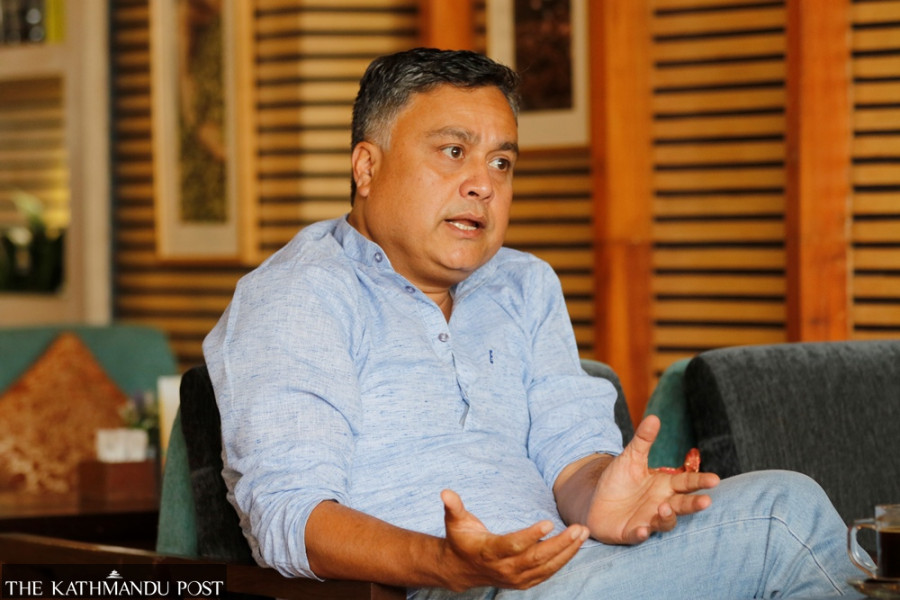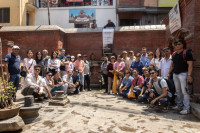Culture & Lifestyle
The serendipitous endeavours of Girish Giri
Giri has been an accomplished writer, biographer, and documentary filmmaker, but he still values journalism above everything else.
Shranup Tandukar
Girish Giri is larger than life. As he sits on a sofa in a cafe permeated with the scent of fresh coffee, he animatedly recalls his experiences. His body movements flow in tandem with his vocal tones. He sits back when his stories arrive at a lull; his hand gestures add motion to his stories; his voice rises and booms during the climax of his stories. He smiles often and openly, his whole face radiating in a momentary chuckle. Everything about him—his smile, movements, gestures, and vocal tones—carry a trace of his boisterous nature.
Giri has been an adept journalist for over three decades. His articles, which usually revolve around social issues, attempt to provide an in-depth and unbiased perspective. He has also been privy to diverse newsrooms around Nepal—from Kantipur Daily, Nagarik, Setopati to Deshsanchar, among others.
But journalism isn’t his only forte. He wears many hats; he is a celebrated documentary filmmaker, a writer, and a biographer. In his most recent quest, he became a biographer of the centenarian writer and historian Satya Mohan Joshi. The biography, titled ‘Satya Mohan’, was released in March 2022.
“As a journalist, I would often turn to Satya Mohan Joshi for quotes for articles,” says Giri. “However, when I left the newsroom behind and started to have casual talks with Joshi without any prior questions, I found out that he had an immense depth of knowledge about the entire cultural heritage of Nepal and not only Newa culture.”
The 308-page biography is written in a first-person narrative as if Giri himself saw the world through the eyes of Satya Mohan Joshi. During a press meet for the launch of the biography, even Joshi had remarked, “Giri himself became Satya Mohan Joshi… he became me… and wrote this book.” The biography, with its 31 chapters, delves into diverse experiences of Joshi—from the 1934 Nepal-India earthquake, a visit to New Zealand, winning three Madan Puraskars to the abduction of the Bishnu Bikranti statue.
“When I heard Joshi’s stories, I was awestruck, and I told him that even I, a veteran journalist, had never known the details of history that he told me,” says Giri. “Satya Mohan Joshi is such an important figure in our history that I felt that writing his biography is imperative for his knowledge to be preserved for our younger generation.”
Giri has been writing a series of memoirs about Joshi for Setopati since 2018, but Joshi, during a conversation with the owner of Book Hill, Bhupendra Khadka, notable Nepali writer Kumar Nagarkoti, and Giri, expressed a desire for his biography to be written by Giri.
“It was such a fortuitous moment for Joshi to have made that remark,” says Giri. “If he had made that remark when we were alone, I would have just agreed but I don’t think things would have materialised. However, since a publisher and a writer were present when he made that remark, the feasibility of pursuing the biography was instantly discussed and plans made to make it a reality.”
It wasn’t the first time Giri had been in the right place at the right time. In 2004, Giri was in Birgunj and heard from his friends that the local football team was going to compete in a tournament in Bihar, India.
“Since I played football in my childhood, I had first-hand experience of the journey that Nepali football players take to compete in Indian competitions,” says Giri. “It looks like a simple thing at first glance—a local Nepali team goes to compete in an Indian competition. It is a simple story, but it also shows how a local team traverses national lines each year to participate in another nation’s tournament and how the players do so with their own knowledge, talent, and work.”
With a camera and recording equipment that he borrowed from his friends, Giri set out to shoot an impromptu documentary. Since there wasn’t enough recording tape, Giri had to spend his own money to buy more—an amount of Rs 800, which became the only expense Giri bore for producing the documentary.
In 2005, he released his documentary titled ‘Team Nepal’, which became Nepal’s only submission to Film South Asia that year. Following the journey of a local football team to a competition in Bihar, India, the documentary provided a glimpse into Nepali and Indian culture that co-exists and adapts to each other in the backdrop of an open border.
After premiering at Film South Asia 2005, the documentary went on to win the Mention Award at the 23rd Sports Movie and TV International Festival in Italy. It was also included in Traveling Film South Asia in 2006 and Toronto Nepali Film Festival in 2012.
“It was a surreal experience to garner such acclaim from people all around the world for my documentary,” says Giri. “Since I had no technical knowledge about documentary filmmaking, I wasn’t sure what to expect.”
For Giri, life imitates art. Since journalists tend to interact with people from diverse backgrounds, especially in art, the interactions often rub off on the journalists as well. Famous writers—like George Orwell, Charles Dickens, and Ernest Hemmingway—have transitioned into writing from journalism.
“While documenting stories, we [journalists] reach different areas of society—from theatre plays, documentary screening, film festivals to poet gatherings. We meet a host of creative individuals for journalism, and these interactions subconsciously also ignite a passion for different arts in a journalist,” says Giri.
Sometimes, however, a necessity leads to creation rather than simple chance meetings. In 2015, violent protests erupted in Tarai places—like Birgunj, Rajbiraj, and Bhardaha, among others—as the country proposed a seven federal-state setup. In the subsequent weeks, an unofficial blockade by India caused a widespread shortage of fuel as well as medical and food supplies. At that time, Kathmandu suffered from fuel scarcity, while Birgunj suffered from violent protests.
Giri, who was born and brought up in Birgunj, was then in a dilemma. As a native of Birgunj, he wanted to speak up for his birthplace, but the situation in Kathmandu was tense and the people agitated.
“One day, I left Kathmandu, and I returned to Birgunj. I did some reporting from Birgunj, but I felt that I couldn’t encompass all that was happening behind the scenes in short reporting pieces,” says Giri.
“When I was in Kathmandu, I was also blaming Birgunj and its natives, but when I came to Birgunj and found out about the ground reality, my perspectives changed,” he adds.
But Giri felt that he couldn’t encompass all the multifaceted perspectives that were present in Birgunj at that time in brief news articles. So he set about writing a biography of the city.
“There were not many books that fell under the city biography genre in Nepal. Even now, there are only a few books,” he says. “People used to be curious and ask: Can you even write a biography about a city? But I wasn’t confused. I spent around two months during the height of protests in Birgunj and I wrote the book.”
In March 2016, Giri published his debut book, ‘Birgunj: Mero Sahar Ko Katha’, in which he attempted to explore the origin, demography, and contemporary situation of Birgunj through the lens of ordinary natives of Birgunj.
“During the Madhesh protests, things were going at their own pace in Birgunj, and it seemed like there was a miscommunication between Birgunj and Kathmandu. Birgunj wasn’t able to express what it was going through to Kathmandu,” he says. “So I wrote the book seeking to shed light on the actual reality of Birgunj.”
His documentary, book, and biography have received praise and success, but he considers these endeavours simply serendipitous and not a prelude to a change in profession.
“All other tasks that I have been involved with are just things that came to me in the course of my journalism career. I never consciously set out to become a documentary filmmaker, writer, or biographer,” says Giri, without a trace of hesitation. “I am a journalist first and foremost.”




 17.49°C Kathmandu
17.49°C Kathmandu















